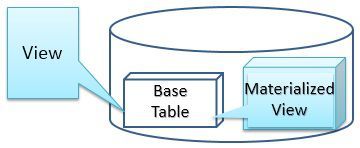- Published on
Optimizing SQL Performance - Advanced Techniques for Faster Processing
- Authors
- Name
- Mohit Appari
- @moh1tt
In this blog we're gonna look at the difference between Non-Materialized and Materialized types of creating tables for faster data querying and performance.
So what's the difference between Materialized and Non-Materialized Views
Materialized views and non-materialized (or regular) views are both database objects that store the result of a query. However, they differ in how they store and update their data.

Let's look at Non-Materialized Views:
- Also known simply as "views", these are virtual tables that are defined by a query.
- When you query a non-materialized view, the database executes the underlying query and returns the results as if they were coming from a table.
Non-materializedviewsdo not storedata themselves; they are essentially saved SQL queries.- Every time you query a non-materialized view, the underlying query is executed, which means it reflects the current data in the underlying tables.
- Non-materialized views are useful for simplifying complex queries, providing security by restricting access to certain columns or rows, and abstracting the underlying schema from users.
Common Table Expressions (CTE), Subqueries and Views are all Non-Materialized Views
Subqueries
These are the most basic type of queries that we ususally use in our SQL queries. They are used to return data that will be used in the main query as a condition or a column.
Let's assume we have a table TableA and TableB and we would like to derive few columns and perform some analytics to finally provide a consise version of the data. So, a regular query would typically look like,
SELECT * FROM TableA A
JOIN (SELECT * FROM TABLEB where soumething>5) B
ON A.id = B.id AND A.id2 = B.id2
We call this type of query as a Subquery.
Common Table Expressions (CTE)
Common Table Expressions (CTEs) are temporary result sets that are defined within the scope of a single SQL statement, particularly within the WITH clause. They allow you to define a named temporary result set that can be referenced within the same SQL statement, which makes complex queries more readable and manageable. CTEs can be thought of as similar to views, but they exist only for the duration of the query execution.
WITH Bb AS (
SELECT * FROM TABLEB where soumething>5
)
SELECT * FROM TableA A
JOIN Bb
ON A.id = Bb.id AND A.id2 = Bb.id2
This takes the same time as the above subquery but in terms of readability and maintainability, CTEs are better.
Views
A view in SQL is a virtual table that is based on the result set of a SELECT query. It's essentially a stored SQL query that you can treat as if it were a table. Views do not contain any data themselves; instead, they provide a way to represent data from one or more tables in a structured format.
They are very useful when queries are shared across various domains and are used in multiple places abstracting the underlying schema from the users.
CREATE VIEW Bb AS
SELECT * FROM TABLEB where soumething>5
SELECT * FROM TableA Aa
JOIN Bb
ON A.id = Bb.id AND A.id2 = Bb.id2
One of the cons can be when you try to drop Aa table, it will throw an error as the view is dependent on the table. With that said, lets move on to the next type of views, Materialized Views.
Materialized Views
These are also known as Snapshot or Cached views. They are similar to non-materialized views in that they are defined by a query, but they differ in how they store and update their data.
Temporary Tables
Temporary tables are a type of database table that is created and managed within the context of a database session. They are typically used to store temporary data that needs to be manipulated, joined, or otherwise processed within a specific session. Temporary tables are particularly useful when you need to store intermediate results during complex data processing tasks or when you need to store data temporarily for the duration of a session.
These tables are automatically dropped when the session ends.
CREATE TEMPORARY TABLE Bb AS
SELECT * FROM TABLEB where soumething>5
SELECT * FROM TableA Aa
JOIN Bb
ON A.id = Bb.id AND A.id2 = Bb.id2
They are way faster and efficient with complex queries and large datasets.
Materialized Views
The only difference between Materialized Views and Temporary Tables is that the former is stored in the database and the latter is not. This creates a table that is stored in the database and can be queried like a regular table.
CREATE MATERIALIZED VIEW Bb AS
SELECT * FROM TABLEB where soumething>5
SELECT * FROM TableA Aa
JOIN Bb
ON A.id = Bb.id AND A.id2 = Bb.id2
The main advantage of materialized views is that they can be indexed, which can significantly improve query performance.
There you go, these are the different types of views and tables that can be used to optimize the performance of your SQL queries. They can be really helpful for powerful analysis and data processing tasks.
Make sure to use CTEs rather than subqueries for better readability and maintainability. And if the queries are complex and large, used frequently and required to be updated frequently, then go for Materialized Views.